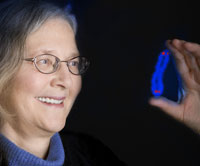Nobel Prize in Physiology or Medicine for Elizabeth Blackburn laureate of L’OREAL-UNESCO award

- © Micheline Pelletier
Australian-born Elizabeth Blackburn was awarded the Nobel Laureate for Medicine today, 18-months after receiving another international distinction, the L’OREAL-UNESCO Prize for Women in Science. Elizabeth Blackburn is professor of the Department of Biochemistry and Biophysics at the University of California (USA).
In 1985, she and her graduate student, Carol Greider, reported the discovery of telomerase, the enzyme that restores the ends of chromosomes by replenishing telomeres, the protective caps that seal off these chromosome ends. The telomerase enzyme is found in almost all cells of higher animals and is crucial to normal cell growth. Chromosomes that lose their protective caps (telomeres) lose the ability to replenish themselves and no longer divide normally to give rise to healthy new cells. As we grow older, telomerase is not always active and telomeres shorten. This loss of the ability to regenerate cells is behind one popular theory about why we age. Yet telomeres also play a role in uncontrolled cancer growth and metastasis. Telomerase levels are high in 80–90% of malignant tumors, where the enzyme’s activity causes the cancer cells to grow and divide rapidly. Unregulated cell division is the hallmark of cancer.
Prof. Blackburn’s research has opened up a new area of inquiry into potential cancer therapies that would block production of the telomerase enzyme and thus hinder the cells’ ability to replicate. The opposite approach could be considered for the treatment of age-related and neurodegenerative diseases: reactivating the enzyme to prolong cell life.
This year's Nobel Prize in Physiology or Medicine is awarded to three scientists who have solved a major problem in biology: how the chromosomes can be copied in a complete way during cell divisions and how they are protected against degradation. The Nobel Laureates have shown that the solution is to be found in the ends of the chromosomes – the telomeres – and in an enzyme that forms them – telomerase.
The discoveries by Blackburn, Greider and Szostak have added a new dimension to our understanding of the cell, shed light on disease mechanisms, and stimulated the development of potential new therapies.
This is the 100th time the Nobel Prize in Physiology or Medicine has been awarded, and the first time that any Nobel Prize in the sciences has been awarded to more than one woman.
Related links:
:: The Telomere, Function and Synthesis [.pdf]
:: UNESCO "Women in Science" Programme (More)
:: A World of Science, Vol. 6, N°2 p.10 (April - June 2008) [.pdf]
:: The UNESCO Courier (More)
- Source:UNESCO SC
- 05-10-2009

